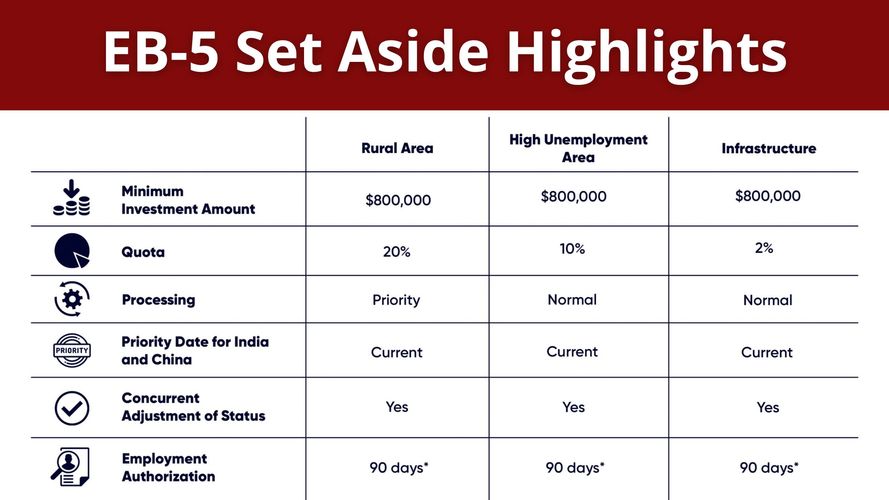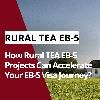Set Aside EB-5 Visas: Benefits and Advantages
Explore the benefits of Reserved and EB5 Set Aside Visas at Paperfree. Discover how they offer unique advantages for investors and immigrants.last updated Friday, April 11, 2025
#Set Aside EB-5 Visas #Reserved EB-5 Visas
| | by Sidra Jabeen | Content Manager, Paperfree Magazine |

QUICK LINKS
AD
Get Access to EB 5 Visa Investment Projects
Key Points
- Reserved EB-5 Visas introduced by the EB-5 Reform and Integrity Act aim to address visa backlogs for investors from high-demand countries like China, India, and Vietnam.
- Three categories of Set Aside EB-5 Visas were introduced: rural TEA projects (20%), high-unemployment TEA projects (10%), and infrastructure projects (2%).
- Reserved EB5 Set Aside Visas allow investors in these categories to bypass waiting lines and immigrate to the U.S. more quickly.
- The allocation of reserved visas is based on the U.S. Department of State's determination, with unused visas moving to the next fiscal year.
- In the EB Visas, The introduction of 5th set program set-asides and concurrent filing for I-485 offer benefits to EB-5 investors, shortening processing times and improving investment repayment timelines.
While the reauthorization of the Regional Center program and the clarification of minimum investment requirements garnered significant attention during the enactment of the EB-5 Reform and Integrity Act, it's important to note that introducing reserved or set-aside visas is also a transformative change.
This development can pave the way for U.S. permanent residence for investors, especially those from high-demand and high-backlog countries like China, India, and Vietnam. For more information on these changes and their impact, you can visit paperfree.com.
What Are Reserved Visas?
The EB-5 Immigrant Investor Program functions within a quota system, providing a specific number of visas each fiscal year. However, due to the limited allocation for each participating country, high-demand nations frequently need more than their allotted visas, resulting in application backlogs.
On March 15, 2022, President Biden enacted the EB-5 Reform and Integrity Act, substantially updating the EB-5 program's requirements.
Notably, this legislation introduced three categories of visa set-asides. These provisions are especially advantageous for foreign investors hailing from countries with historical backlogs, as they enable a faster immigration process, allowing them to bypass the waiting queue and move swiftly toward U.S. immigration.
What are the Current EB5 Set-Asides Categories?
The U.S. Department of State (DOS) plays a pivotal role in determining the annual allocation of visas for the EB5 program.
A specific number of visas is designated for this program each fiscal year, and each participating country is granted approximately 7% of this yearly total. Notably, any unused visas by the end of the fiscal year are reallocated to immigrant investors from countries with high demand.
In the 2022 fiscal year of EB-5 Visa Advantages, the DOS has earmarked approximately 19,880 EB5 visas for allocation. Within this total, a significant portion, 32%, has been set aside.
The Revised Immigration Act (RIA) has established specific quotas within the EB-5 visa program, earmarking a certain percentage of visas each year for targeted investment projects. Here's a breakdown of these allocations:
- Rural Projects: 20% of the annual EB-5 visas are dedicated to investments in rural areas, reflecting a commitment to stimulating economic growth outside of urban centers.
- High Unemployment Projects: Projects in regions with high unemployment rates receive 10% of the visa pool, aiming to create jobs where they are most needed.
- Infrastructure Projects: Although only receiving 2% of the visas, this category focuses strategically on funding significant infrastructure improvements across the country.
This structure ensures that specific types of development projects receive focused attention and investment under the EB-5 program.
Importantly, if any of these reserved visas remain unutilized at the close of the fiscal year, they are carried over to the subsequent year within the same categories.

EB-5 Program Requirements for Targeted Employment Areas (TEAs)
In the EB-5 Quota, TEAs, which stand for Targeted Employment Areas, are typically geographical areas composed of census tracts or clusters of census tracts that have received recognition from Congress as requiring economic growth and job creation.
What sets TEAs apart is the lower minimum investment threshold of $800,000, in contrast to the standard requirement of $1,050,000. This lower threshold incentivizes investments in TEAs, benefiting foreign investors and the U.S. government by stimulating economic development in regions in greater need.
Learn more about EB5 Investment Amount
TEAs encompass two main categories:
- rural,
- high-unemployment areas.
Specific types of public infrastructure projects can also qualify as TEAs, allowing them to benefit from the reduced minimum investment requirement.
To meet the requirements of the EB-5 program, EB-5 Visa Benefits for rural TEAs must meet specific criteria:
- they should have a population of fewer than 20,000 residents,
- be located outside of a metropolitan statistical area (MSA),
- and does not share a direct border with a municipality with a population exceeding 20,000 residents.
High-unemployment TEAs must have an unemployment rate of at least 150% of the national average. Furthermore, they should be situated within either a Metropolitan Statistical Area (MSA) or an urban area with 20,000 residents or more.
The introduction of the infrastructure projects category is a recent development in the EB-5 industry. However, immigrant investors still need further clarification regarding the types of projects that could qualify under this category.
What are the Effects of Visa Set-Asides for Specific Countries?
Investor Immigration Countries with high demand for EB-5 visas often surpass the annual quota, resulting in visa backlogs and established cutoff dates. These backlogs can force investors to wait for extended periods, sometimes years, to receive their visas.
As of July 2022, China is the sole country with assigned cutoff dates.
EB-5 applicants who select TEA or public infrastructure projects and submit Form I-526 after March 15, 2022, gain eligibility for reserved visas upon approving their I-526 petitions.
This means that applicants falling into these three reserved categories can acquire their visas and initiate their U.S. immigration process more swiftly, particularly when their home countries encounter visa backlogs in the unreserved visa categories.
Introducing reserved visas is particularly advantageous for investors from countries at risk of experiencing visa backlogs and cutoff dates. Notably, most countries participating in the EB-5 program have relatively low demand and do not surpass their annual visa allocation.
Reserved and Set Aside EB-5 Visas
Before the Reform and Integrity Act (RIA) was enacted, visa availability was determined by the Priority Date or when an investor's I-526 petition was submitted. Investors with earlier Priority Dates received visas ahead of those with later dates.
This rule applies regardless of whether it is a direct investment, an RC investment in a non-TEA project, or a TEA investment. This meant that an investment in a luxury condo in an upscale area was treated equally to a more impactful project in a high-unemployment TEA.
The RIA aimed to rectify this by introducing reserved visas for investors opting to invest in specific categories. Approximately one-third of all visas available in a fiscal year are now reserved or set aside.
10,000 Visas Allocated for the Fiscal Year
| Investment Category | % of total visas | No. of visas |
| Projects in rural areas | 20% | 2000 |
| Projects in high-unemployment areas | 10% | 1000 |
| Infrastructure projects | 2% | 200 |
| Unreserved | 68% | 6800 |
This change signifies that an investor who chooses to invest in an RC project or directly invest in a rural area will now have a distinct pool of EB-5 visas available to qualify for a U.S. green card by proving its EB 5 Visa Availability.
The EB-5 program typically allocates approximately 10,000 visas annually, with a per-country cap of 7%, which equals 700 visas. Before the introduction of the RIA, these 700 visas were distributed on a first-come, first-served basis, regardless of the type of investment made by EB-5 investors.
For instance, let's consider a scenario where 900 EB-5 petitions have been submitted by citizens of Sri Lanka.
Before Reform and Integrity Act (RIA)
| No. of visas | |
| Available visas | 700 |
| I-526 petitions | 900 |
| Backlog | 200 |
In this situation, the number of petitions, 900 in total, surpasses the per-country cap of 700 visas, resulting in 200 applicants having to wait. Before implementing the RIA, an investor's Priority Date was the sole determining factor in visa allocation.
The first 700 investors with earlier Priority Dates would be eligible for visas, while the remaining 200 investors with later Priority Dates would need to wait for their turn.
Impact of Reserved/ Set Aside Visas
| Total | Unreserved (68%) | Rural TEA (20%) | High Unemployment TEA (10%) | Infrastructure Projects | |
|
Available visas |
700 | 476 | 140 | 70 | 14 |
| I-526 petition | 900 | 690 | 140 | 70 | 0 |
| Backlog | 214 | 0 | 0 | 0 |
The RIA introduces a new system for visa allocation, affecting which category of investors may experience delays in obtaining visas.
Even if the 140+70=210 TEA investors have a later priority date, the reserved visa categories guarantee they will still receive their visas.
Meanwhile, individuals in the unreserved category may need to wait for unused visas from other countries to become available or wait until the next fiscal year to issue fresh visas.
- Rural TEAs
Rural TEA set-asides are highly appealing due to the significant percentage of visas reserved for this category. Rural TEA Projects do not have specific unemployment requirements, providing investors with a broader range of project options to qualify for reserved visas.
The following conditions must be fulfilled for a project to qualify as a rural TEA.- The location’s population should not be more than 20,000 residents.
- It must not border a municipality with more than 20,000 residents.
- The project must be located outside metropolitan statistical areas (MSAs).
- High-Unemployment TEAs
The definition of a high-unemployment TEA remains the same, with the area's unemployment rate required to be at least 150% of the national average or higher. This option is more familiar to investors, but there is a higher likelihood that the set-aside for this category may be utilized rapidly. - Infrastructure Projects
These projects encompass government-sponsored initiatives and may also encompass privately funded endeavors. This represents a new investment avenue with relatively few visas allocated for this category.
Good News - Concurrent Filing and Set-Asides
In addition to introducing set-asides, the RIA has granted EB-5 investors the opportunity to submit their I-485 alongside the I-526 petition simultaneously. The latter is the EB-5 visa petition, while the former is filed toward the end of the two-year conditional permanent residence period.
The primary advantage of concurrent filing is that the petitioner can enjoy nearly all the benefits and privileges of permanent residence while awaiting the petition's adjudication.
It's important to note that the RIA allows concurrent filing only if the visa is available at the time of the I-526 petition submission and at the time of adjudication. Countries like China, India, and Vietnam, which experience lengthy backlogs in the unreserved category, may be unable to take advantage of the concurrent filing benefits.
The set-asides apply to all countries, signifying that an investor opting for the reserved visa will effectively become a permanent resident upon the approval of the I-526 petition and the commencement of the two-year conditional permanent residence period.
Impact on Repayment Period On EB 5 Set Aside Visas
- Before the RIA, EB-5 rules mandated that investments remain at risk throughout the two-year conditional permanent residence period.
- However, this posed a challenge when there was a substantial gap between the approval of the I-526 petition and the availability of the EB-5 visa.
- The introduction of set-asides effectively addresses this issue, enabling investors to bypass the problem of visa unavailability.
- As a result, the requirement to keep the investment at risk can be met more expeditiously, leading to quicker repayment by the Regional Center project.
- On October 11, 2023, USCIS issued updated guidance on the revised EB5 investment timelines under the RIA, stating that investors only need to maintain their investment for two years from their investment in a new commercial enterprise to qualify for an EB5 visa.
Effect on EB-5 Visa Processing and Wait Times
Opting for the EB-5 Reserved Visa category substantially reduces processing and wait times for immigrant investors, particularly those from high-demand countries. The RIA introduced a priority processing system for I-526/I-526E petitions filed by investors in rural, high-unemployment, and infrastructure projects, resulting in expedited EB-5 Visa Processing and Wait Times.
As a result, approving I-526/I-526E petitions takes 12 months, significantly shorter than the previous average EB5 processing time of 29 months.
Carryover of Unused Reserved Visas
Any EB-5 Reserved Visas that go unused within a fiscal year are rolled over to the subsequent fiscal year, starting on October 1 and concluding on September 30 of the following year.
This process entails incorporating these leftover set-aside visas into the overall count of newly available EB5 visas for each fiscal year. This carryover mechanism augments the visa numbers accessible under the EB-5 set-aside category.
How the Regional Center Program Could Affect the Eb5 Set Aside Visa Supply
Until June 2022, it appeared that regional centers would need to undergo a recertification procedure to align with the updated regulations introduced in the EB-5 Reform and Integrity Act.
The regional center program had long been the favored investment choice within the EB-5 industry.
Regrettably, the regional center program relies on periodic reauthorization, and in June 2021, Congress did not extend this aspect of the EB-5 industry. Consequently, the expired regional center program prevented investors with pending I-526 petitions from advancing in the visa application process.
The regional center program was finally reauthorized with the enactment of the EB-5 Reform and Integrity Act on March 15, 2022.
This allowed EB-5 investors with pending I-526 petitions in regional centers to proceed with their EB-5 visa applications. However, USCIS did not accept new applications from regional center investors during this period.
The application process for regional center designation underwent revisions, and many regional center owners concentrated on achieving recertification.
The timeline for USCIS to resume accepting new I-526 petitions under the regional center program was uncertain. However, a significant development occurred on June 24, 2022, when a court ruling reauthorized this highly popular investment model.
This decision resulted from litigation initiated by several EB-5 regional center managers who sought permission to resume their operations immediately.
The ruling favoring the regional center operators' litigation is a positive outcome for all stakeholders involved in the EB-5 program.
This reauthorization is expected to bring a surge of new investments into the industry. Regional centers offer numerous advantages to investors, including more flexible criteria for calculating job creation.
The Reform and Integrity Act also introduced stringent transparency measures to ensure that funds within the regional center program are managed prudently and directed toward appropriate projects.
Additional EB-5 Visas for 2024. Over 5,000 Rural Eb5 Set Aside!
The recent release of visa availability figures for fiscal year 2024 brings excellent news for EB-5 investors, especially those from China and India.
Instead of the usual annual quota of 10,000 EB-5 Visas, the allocation for 2024 has significantly increased to 22,233 EB-5 Visas. This development is highly favorable for both our existing and potential investors.
It not only relieves the backlog for Indian and Chinese investors who applied before implementing the EB-5 Reform and Integrity Act (RIA) but also extends the timeframe before a backlog may arise for post-RIA investors.
These additional Visas can be further classified into four distinct categories:
- RURAL SET-ASIDES
5,071 reserved set-aside Visas have been allocated for post-RIA investors engaging in rural projects. This provision is strategically crafted to streamline the visa process by granting priority processing to investors from China, India, and Vietnam. As a result, these investors can bypass the backlog and experience a faster immigration journey. - HIGH UNEMPLOYMENT SET-ASIDES
An additional 2,535 reserved set-aside Visas have been designated for post-RIA investors participating in non-rural TEA projects. This allocation aims to facilitate a smoother visa process for these investors. - INFRASTRUCTURE SET-ASIDES
507 Reserved set-aside Visas have been assigned for post-RIA investors engaged in infrastructure projects. This allocation will streamline the visa application for individuals investing in such projects.
Unreserved Visas for EB 5
A significant portion of 14,120 Unreserved Visas for the Eb 5 Visa Backlog is available for pre-RIA and non-TEA investors. These visas are primarily intended for pre-RIA investors affected by the backlog in countries such as China, India, and Vietnam. Pre-RIA investors from other countries who receive I-526 approvals this year will also benefit from this allocation.
EB5 United is delighted to share this news with you. Please get in touch with us if you would like more information about our Rural EB-5 projects. We recommend referring to the following article in EB5 Investor Magazine for a detailed breakdown of how visa availability is calculated.
*RIA – Reform and Integrity Act of 2022 – This changed a Targeted Employment Area (TEA) investment from $500,000 to $800,000 and allotted set-aside visas to skip the Indian and Chinese backlogs for new investors in TEA projects.
Copper Valley: Paperfree’s Vetted Rural TEA EB5 Project
Explore the unique investment opportunity in Copper Valley, a prime EB-5 project nestled in a rural setting. Due to its Rural Set Aside Visa category, Copper Valley ensures faster visa processing. Ideal for investors seeking to benefit from the EB-5 program, Copper Valley promises not only a lucrative investment but also prioritized processing and significant community impact through job creation.
Transform your EB-5 visa journey from years to months! Copper Valley offers a unique investment opportunity within the Rural Set Aside Visa category, promising expedited processing. Contact PaperFree now to receive a comprehensive 60-minute consultation and evaluation, free of charge. Get started with PaperFree today.
Frequently Asked Questions About Reserved EB-5 Visas
What Are Reserved EB-5 Visas and How Do They Benefit Investors?
Reserved EB-5 Visas were introduced by the EB-5 Reform and Integrity Act to address visa backlogs for investors from high-demand countries such as China, India, and Vietnam. These visas are set aside in three specific categories: rural TEA projects (20%), high-unemployment TEA projects (10%), and infrastructure projects (2%). By creating reserved visa categories, investors in these areas can bypass waiting lines and immigrate to the U.S. more quickly, streamlining the immigration process for those from countries with historically high backlogs.
What Are the Current Categories for EB-5 Set-Aside Visas?
The current categories for EB-5 Set-Aside Visas are determined by the U.S. Department of State and include three main types: rural TEA projects (20% of total visas), high-unemployment TEA projects (10% of total visas), and infrastructure projects (2% of total visas). These categories aim to promote economic development in targeted employment areas (TEAs) and infrastructure projects, making it easier for investors to secure visas and contribute to U.S. economic growth.
How Does the EB-5 Program Define Targeted Employment Areas (TEAs)?
Targeted Employment Areas (TEAs) are geographic regions recognized by Congress as needing economic growth and job creation. TEAs include two primary categories: rural areas and high-unemployment areas. Rural areas have a population of fewer than 20,000 residents, are located outside of metropolitan statistical areas (MSAs), and do not border a municipality with over 20,000 residents. High-unemployment areas have an unemployment rate at least 150% of the national average, situated within an MSA or an urban area with 20,000 residents or more. These areas benefit from a lower minimum investment threshold of $800,000, compared to the standard $1,050,000, incentivizing investment and economic development in these regions.
What Is the Impact of Reserved Visas on Investors from High-Demand Countries?
Reserved visas significantly benefit investors from high-demand countries like China, India, and Vietnam, which often face visa backlogs. Investors selecting TEA or public infrastructure projects and submitting Form I-526 after March 15, 2022, become eligible for reserved visas upon the approval of their I-526 petitions. This means that investors in these reserved categories can obtain their visas and begin their U.S. immigration process more swiftly, bypassing the usual wait times associated with high-demand countries.
How Do Reserved Visas Affect EB-5 Visa Processing and Wait Times?
Opting for the EB-5 Reserved Visa category substantially reduces processing and wait times for immigrant investors, particularly those from high-demand countries. The Reform and Integrity Act introduced a priority processing system for I-526/I-526E petitions filed by investors in rural, high-unemployment, and infrastructure projects. As a result, approving I-526/I-526E petitions now takes approximately 12 months, significantly shorter than the previous average EB-5 processing time of 29 months.
What Happens to Unused Reserved Visas?
Any unused reserved EB-5 visas within a fiscal year are rolled over to the subsequent fiscal year, starting on October 1 and concluding on September 30 of the following year. This process incorporates these leftover set-aside visas into the overall count of newly available EB-5 visas for each fiscal year. This carryover mechanism increases the number of visas accessible under the EB-5 set-aside category, ensuring that no visas go to waste and that more investors have the opportunity to benefit from the program.
How Does the Regional Center Program Affect the Supply of Set-Aside Visas?
The regional center program has long been a favored investment choice within the EB-5 industry. However, it relies on periodic reauthorization, which was not extended in June 2021, halting the process for investors with pending I-526 petitions. The program was reauthorized with the enactment of the EB-5 Reform and Integrity Act on March 15, 2022. This allowed EB-5 investors with pending I-526 petitions in regional centers to proceed with their visa applications. The reauthorization and the introduction of reserved visas are expected to bring a surge of new investments into the industry, providing more opportunities for investors to secure U.S. permanent residency.
Book Your Free Consultation with Paperfree EB-5 Visa Experts. Get Personalized Advice and an Investment Plan. Book Your Free Consultation Today!

Conclusion
While the absence of a per-country cap in the set-asides would have provided even more significant benefits for EB-5 investors, introducing reserved visas is undeniably a significant positive step. Acknowledging that investments in rural or high-unemployment projects come with unique risks and challenges is essential.
Therefore, investors should seek professional guidance that covers both reserved and unreserved project investments before embarking on their EB-5 journey. This prudent approach ensures investors make informed decisions and navigate the process effectively.
Pages Related to #Set Aside EB-5 Visas
- EB-5 for Tech Entrepreneurs: Immigration Program for Startup Founders | Paperfree

- EB-5 Visa for Rural Areas to Accelerate Your EB-5 Visa Journey

- U.S.-Based EB-5 Investors Surge in 2025 | Concurrent Filing & Loan Repayment Explained

- Joseph Edlow Confirmed as New USCIS Director

- EB 5 due diligence checklist. EB-5 due diligence process.

- Benefits of Eb 5 Visa Program by Paperfree EB5

- Rural EB-5 Projects for foreign investor looking for expedited processing.

- EB-5 Funding 3.0 for Investors | EB5 Visa

Popular Page
Benefits of the EB-5 Visa Program| A Comprehensive Guide
Book a Free Complimentary Call
Search within Paperfree.com
real estate investing Investment Visa USA Investment Magazine Private Real Estate Funds real estate funds
